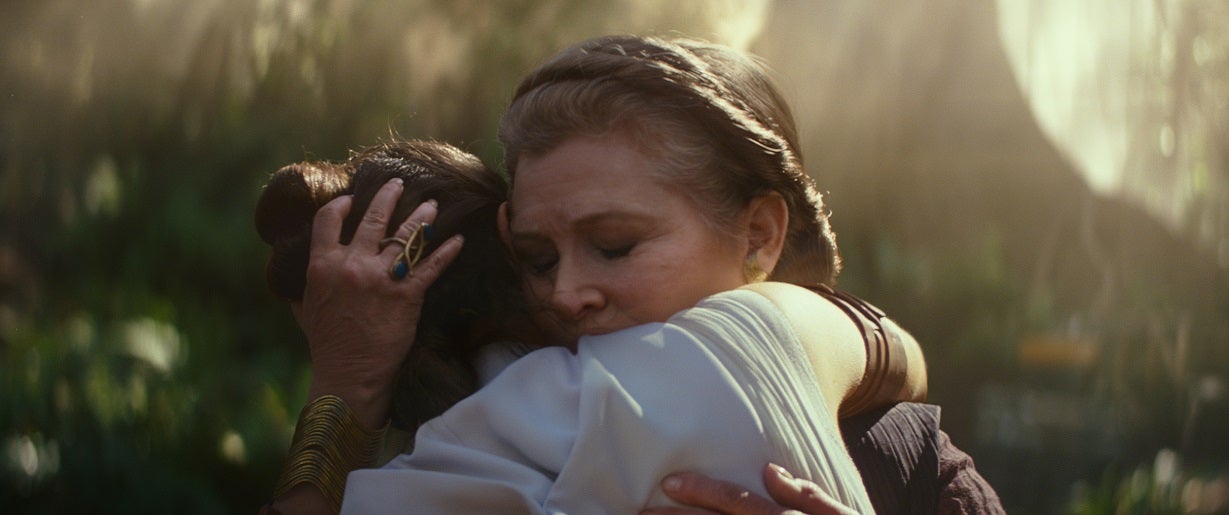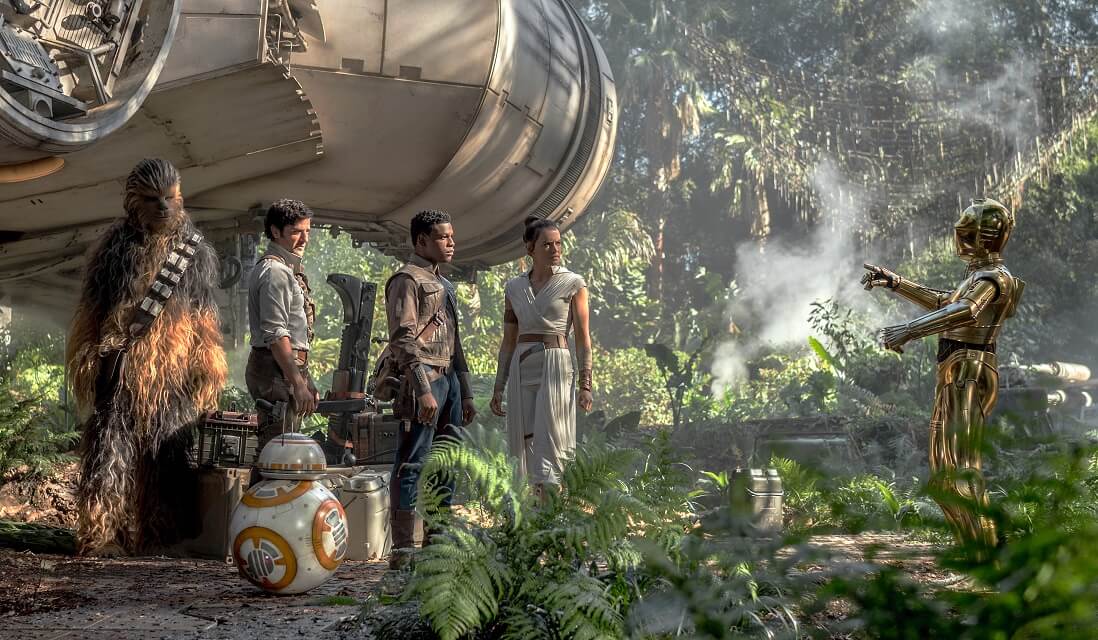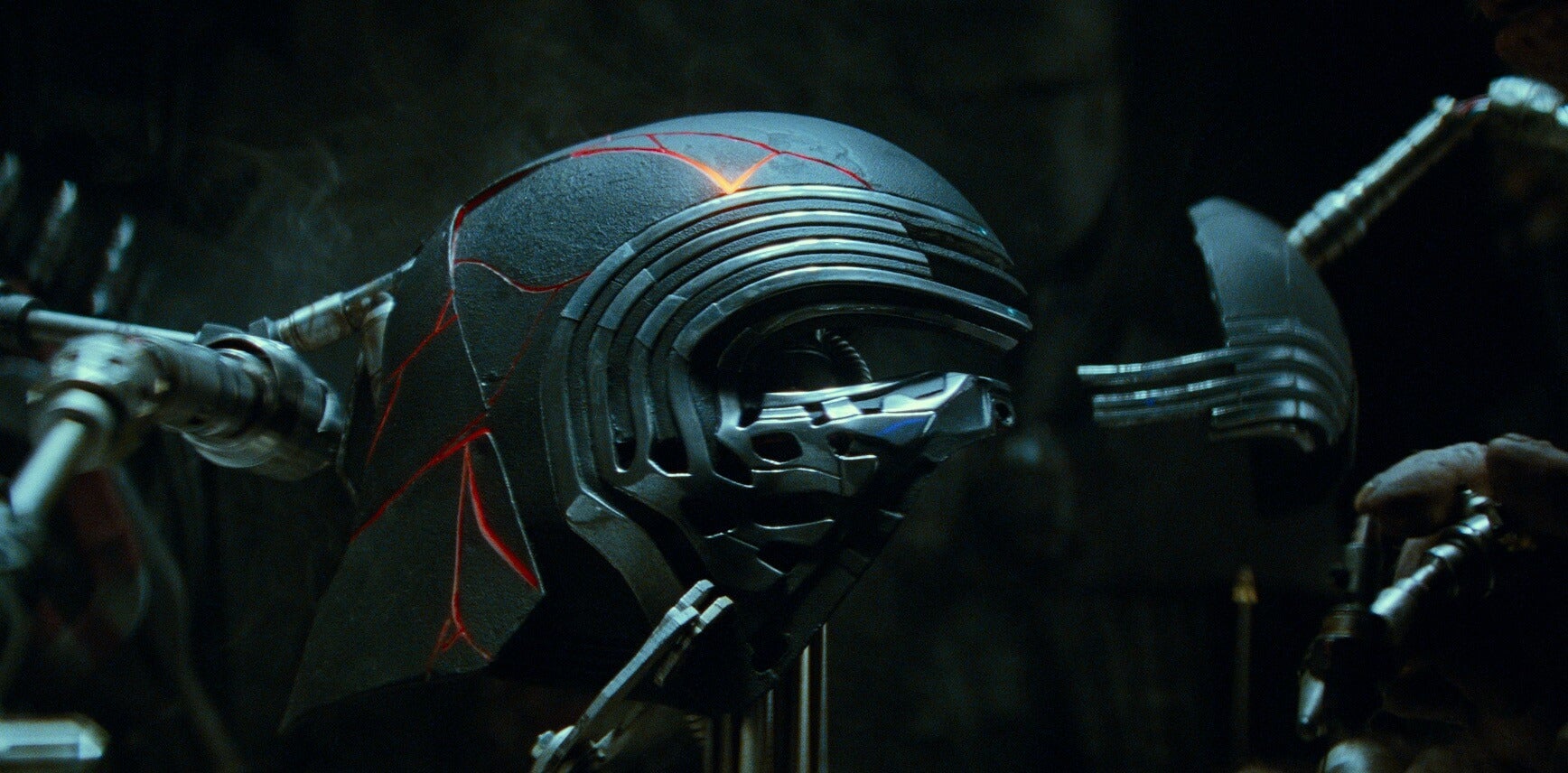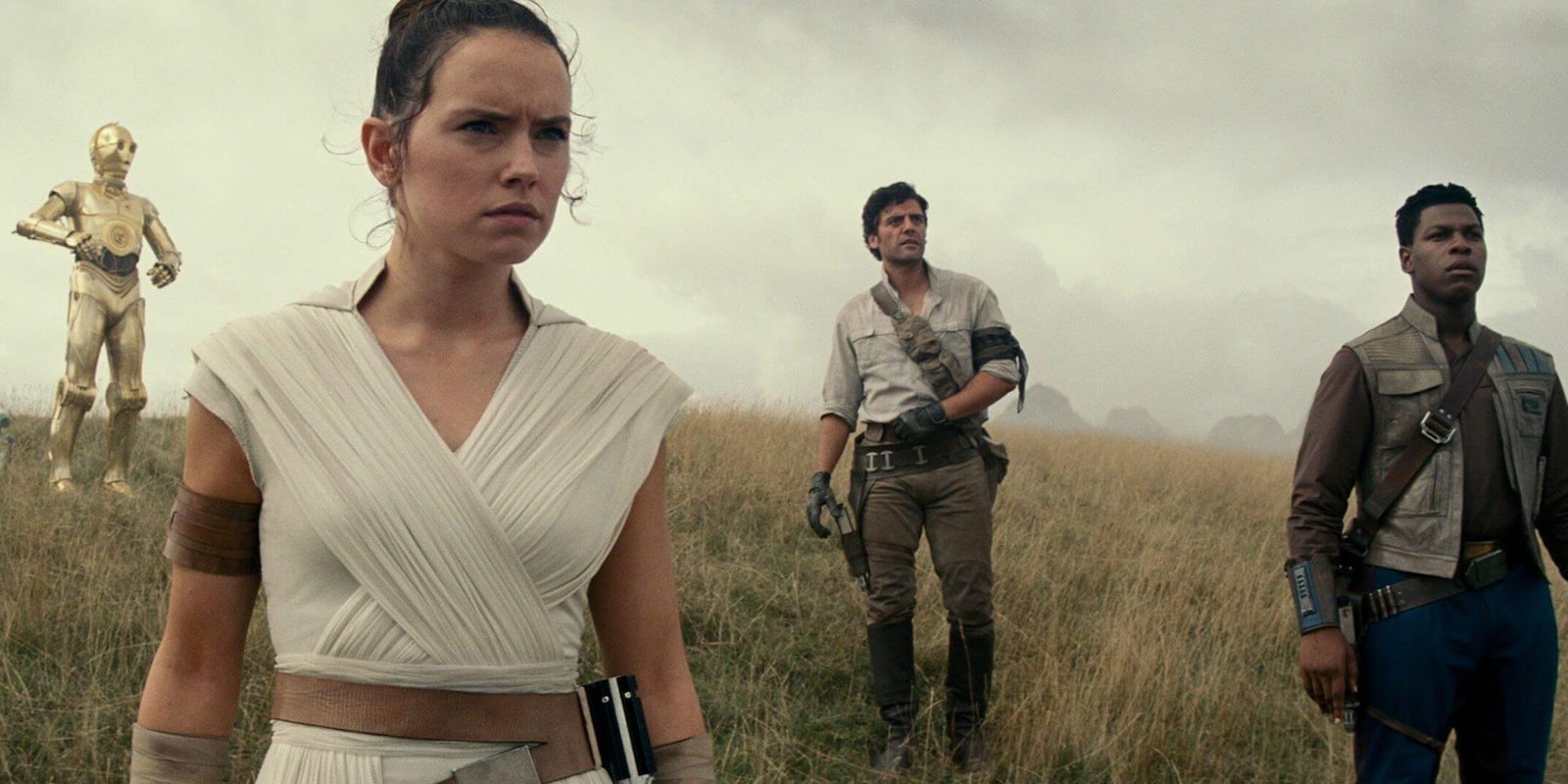This review contains no major spoilers for Star Wars: The Rise of Skywalker.
Lower your expectations, folks. Concluding the nine-movie Star Wars saga, The Rise of Skywalker simultaneously pushes back against the thematic depth of The Last Jedi and fails to grab the more straightforward thrills of The Force Awakens. In a move that’s sure to be hideously divisive, the film leans heavily on empty nostalgia, shoehorning legacy characters into a meandering treasure hunt for Sith artifacts. Certain elements seem directly aimed at an obnoxious minority of conservative fanboys, including sidelining The Last Jedi’s breakout character Rose Tico (Kelly Marie Tran), whose tiny role consists of delivering lines like, “General, we have the coordinates!”
DIRECTOR: J.J. Abrams
RELEASE: Theatrical
Backtracking on the bold narrative choices of ‘The Last Jedi,’ director J.J. Abrams concludes the Skywalker Saga with a clumsy appeal to nostalgia and the more conservative side of Star Wars fandom.
Regardless of your feelings on nostalgia, this movie has a bad script. Co-written by director J.J. Abrams (The Force Awakens) and Chris Terrio (Batman v Superman), it’s full of uninspiring dialogue where characters baldly explain things to each other, interspersed with quips that feel more Marvel-esque than the easy charm shared by Finn (John Boyega), Rey (Daisy Ridley) and Poe (Oscar Isaac) in the last two films. Political commentary on the Resistance/First Order war is surprisingly minimal, mostly rehashing ideas they already covered. And much of the story follows a location-hopping quest to find a series of MacGuffins, at one point playing the narrative equivalent of Three Card Monte with a pair of lightsabers.
One of the key problems is something the film’s creators and fans are understandably hesitant to discuss: Carrie Fisher’s death. Originally, Leia was meant to play a major part like Han and Luke did in the last two movies. When Fisher passed away in 2016, Disney had to change tack for The Rise of Skywalker, which now has four credited screenwriters: Abrams and Terrio, plus additional “story by” credits for Colin Trevorrow and Derek Connolly, who conceived an earlier draft. The resulting film uses brief clips that Carrie Fisher filmed for the last two movies, and it’s hard to ignore the structural ducking and weaving required to insert her into a new story.

Attempting to include Leia as much as possible, we get scenes where someone else’s dialogue was clearly written to fit with whatever Leia footage they had available. If you’re aware of that, you’ll understand why we get an oddly nonspecific conversation where she and Rey hand a lightsaber back and forth. If you’re not aware, you’ll still probably sense that Leia’s role is oddly truncated and shallow. It’s a sensitive situation because Fisher was so universally beloved, and the writers couldn’t just get rid of Leia offscreen. Still, the end result is noticeably awkward. For instance, if you’re wondering why Rey went back to wearing an outfit from the first movie, it’s probably because she had to fit into archival footage with Fisher.
Rogue One and Solo garnered media attention for creative disruption behind the scenes, but The Rise of Skywalker actually came away with more visible structural problems—not to mention uneven characterization and derailed arcs after The Last Jedi. Abrams was apparently determined to undo Rian Johnson’s most interesting creative choices, exemplified by a scene where Kylo Ren welds his shattered helmet back together. You’d better believe that the Knights of Ren (an Abrams creation) get plenty of screentime, but do they get personalities, backstory, or any kind of thematic purpose? Do they hell.
By trying to please ‘the fans,’ this film shot itself in the foot
Daisy Ridley and John Boyega have both spoken about how much they enjoyed working together on The Force Awakens, and how dismayed they were to be separated in The Last Jedi. Over time, this became one of the many controversies around TLJ, with Disney promoting this film a reunion for the main “trio.” The problem is that the trio never existed onscreen. In The Force Awakens, Poe and Finn have a relationship, and Rey and Finn have a relationship. Rey and Poe are total strangers, and Abrams ended the film by splitting them all up: Rey to visit Luke, Poe with the Resistance, and Finn in a coma. Rian Johnson picked up the pieces with separate subplots for each character, and while The Rise of Skywalker brings them together at last, the relationship doesn’t fully land.

Poe gets an especially raw deal because, in order for him to join Finn and Rey, the film jettisons his character development from The Last Jedi. Introduced as a charming and idealistic rebel hero, the second film forced him to confront harsh truths about his flaws as a commander, setting the stage for him to take more responsibility as Leia’s successor. Now he’s back to tagging along with Finn and Rey, introducing a dynamic that feels more forced than familiar. For some reason, Poe’s personality abruptly transforms from “confident and gregarious” to “constantly irritable,” bickering with his friends in a way that’s presumably intended as fun, fast-paced patter. Finn fares a little better, but if you were hoping he’d get a protagonist role, you’ll be disappointed. He certainly gets a lot of screentime, but it was frustrating to see this film drop the ball on any serious emotional development. Finn is explicitly depicted as a hero (something that many fans felt was missing from The Last Jedi), but his role otherwise felt kind of superficial.
Finn and Poe (and arguably the entire Resistance) are secondary to the conflict between Jedi and Sith, starring Rey and Kylo Ren (Adam Driver). Unlike recent Star Wars movies, which emphasize solidarity and the importance of everyday rebellion, Rey’s storyline harks back to the prequel trilogy idea that a ritualized struggle between Jedi and Sith overshadows everything else in the galaxy.
‘A thousand generations live in you now…’
It’s now time to discuss my one and only spoiler of this review, although it’s something we learn in the first five minutes. Inexplicably delving into an already-concluded period of the franchise, Abrams resurrects Emperor Palpatine (Ian McDiarmid) as the main antagonist.
Unlike the more personal threats and anti-fascist politics of the last two films, Palpatine’s return raises the stakes to an absurd, almost meaningless degree. As always, McDiarmid has tremendous fun playing a cackling old zombie wizard. But we simply do not need to see a Rey-centric retread of Palpatine’s seduction of Anakin Skywalker.
Fans of the Rey/Kylo Ren relationship will enjoy how much intense, emotionally charged screentime they share, but the film’s attitude to the Force and the Jedi/Sith war is disappointingly simplistic. After two movies with a more ambivalent and nuanced attitude to the Force, the finale is suddenly obsessed with Sith and Jedi legacies. The sociopolitical ideas that Abrams set up in The Force Awakens—the First Order’s insidious rise as neo-Nazi analogues; the futility of Kylo Ren’s petulant obsession with genetic legacy—are swept aside in favor of the Emperor zapping things with Force lightning.

While Daisy Ridley and Adam Driver give powerful performances as two people locked together in a symbiotic rivalry, their arc requires us to ignore Kylo Ren’s genocidal leadership of the First Order. Rey, caught in a tumult of emotion, is terrified of turning to the Dark Side—yet still compelled by Kylo Ren, her only peer as a Force-user. Meanwhile, Ren is as conflicted as ever, hoping to usurp the Emperor without killing Rey. Building on The Last Jedi’s psychic Skype sessions, the two characters clash again and again, each hoping to convert the other. But in order for this to work, it has to be presented as a spiritual dispute, ignoring the rest of the war. Rey’s desire to save “Ben Solo” only works if we forget that he’s basically Hitler Junior, commanding planetary massacres and enslaving millions of children like Finn. If we’re meant to root for even the hypothetical concept of redemption, we must focus exclusively on the relationship between Rey and Ben Solo, separate from the struggles of the Resistance. It’s a morally and narratively incoherent idea, elevated by Driver and Ridley’s performances.
The poison of nostalgia
Oddly enough, The Rise of Skywalker’s nostalgia content isn’t very effective. In The Force Awakens, Abrams struck an effective balance between new material and fond references to the original trilogy, provoking sentimental nostalgia with visual and thematic callbacks. This film felt much clumsier, particularly the roles given to several returning characters.
Lando Calrissian was a notable example because while he’s a famously distinctive figure, his returning role was oddly un-Lando-like. Was he cool and resourceful, with a faint whiff of moral ambiguity? Not really. He was just Billy Dee Williams wearing an appropriate costume, showing up for a handful of scenes to deliver unmemorable dialogue. As for Chewie and C-3PO, they simply didn’t need to be there. They’re important to a certain subplot, but their roles feel like the result of a brainstorming session for “How do we include Chewie and C-3PO?” It’s especially galling in the context of Rose Tico’s reduced screentime, which tacitly endorses all the racist and sexist backlash against her character.
For a film with such an extensive ensemble cast, the balance between meaningful roles was totally disjointed. General Hux (Domnhall Gleeson) and his new workplace frenemy General Pryde (Richard E. Grant) both had fun little parts to play. Jannah (Naomi Ackie) made an immediate impact as a new Resistance ally. The masked gangster Zorii Bliss (Keri Russell) felt slightly like an unwanted attempt to make Poe Dameron straight, but otherwise got a pretty decent role. It’s the pre-existing heroes who got shafted, from Rose’s background role to Poe’s incoherent personality, to the older characters who honestly should’ve been cut. And that’s without going into the numerous fake-outs where characters “die” but secretly survive; a cheap ploy that undercuts the supposedly high stakes.
I went into The Rise of Skywalker expecting J.J. Abrams to backtrack on some of Rian Johnson’s bolder creative choices, but ultimately deliver a satisfying-but-conservative story like The Force Awakens. The reality was much worse. Along with its transparent desire to coddle fans who hated The Last Jedi, the screenplay lacked the poetry and thematic weight we’ve come to expect. Characters were mishandled and dialogue was bland, dragging the heroes from place to place in a formulaic MacGuffin hunt. Perhaps most surprisingly, it didn’t even measure up to the visual flair of the last two films.
With a colossal team of artists and technicians on staff, Star Wars always offers a cornucopia of gorgeous costumes, props, and alien locations. Visual symbolism and musical cues are central to the franchise’s staying power, thriving on tiny-but-memorable details of design and worldbuilding. Yet halfway through The Rise of Skywalker, I found myself thinking: “Wait. Does this movie look… kind of bad?” Not bad by average blockbuster standards, but certainly subpar for Star Wars. We visit some cool new planets, but the film lacked any equivalent of iconic setpieces like Rey’s introduction on Jakku, or the throne room duel in The Last Jedi. The Palpatine scenes were simply murky. One First Order infiltration sequence felt like a repeat of old material. Aside from a cute new droid, the orbaks (Jannah’s alien horses), and the diminutive Babu Frik, there was an unexpected dearth of charmingly weird background figures, normally the bread-and-butter of the franchise. So while The Rise of Skywalker’s production values were high, J.J. Abrams and cinematographer Dan Mindel (The Force Awakens) kind of dropped the ball.
Amid the conflicting desires to include Carrie Fisher, appease conservative fans, reintroduce J.J. Abrams’ favorite characters, and tie everything back into the Jedi/Sith wars, The Rise of Skywalker is disappointingly muddled. The prequel trilogy tells us that Star Wars fans will find something to love in the worst of movies, and I’m sure that will happen here. But for now, this feels like an artistically and thematically dispiriting conclusion to the saga.
